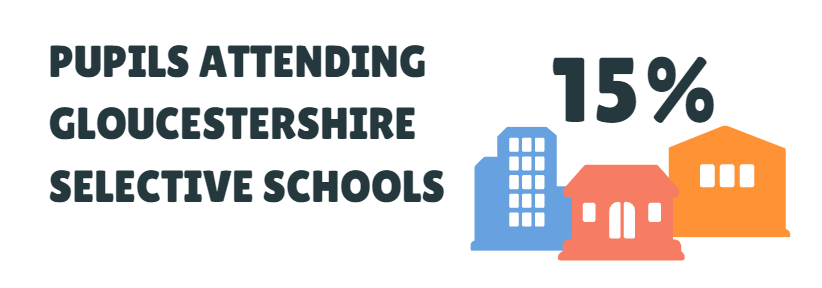 Selective education guide – Gloucestershire
Selective education guide – Gloucestershire
BACKGROUND
There are seven grammar schools in Gloucestershire, with selective schools located in Gloucester, Stroud, and Cheltenham.
Check out our map of selective schools in England to find out more about these schools. The map gives the percentage of disadvantaged pupils, the percentage of pupils attending a grammar school who are likely to have come from a fee-paying ‘prep’ school, and the relative selectivity of every grammar school in Gloucestershire. View the map HERE.
Or, to read stories from parents and teachers experiencing selective education in Gloucestershire visit the 11+ Anonymous site HERE.
THE PROBLEMS
In every area where academic selection still exists there are some common problems. For example,
- Grammar schools admit fewer disadvantaged pupils than non-selective schools. Grammar schools are also more likely to admit pupils from more advantaged families.
- A significant number of pupils previously educated in fee-paying ‘prep’ schools take up grammar school places.
- Better-off families can afford private coaching while poorer families can feel compelled to pay for tuition they can ill afford. Tuition for the 11-plus ‘buys advantage’.
- Sitting the 11-plus is stressful and can damage a child’s confidence.
- The 11-plus has been proven to lack accuracy because it takes place while children are still developing academically.
- Research shows the proportion of children with Special Educational Needs (SEN) attending grammar schools is small. For many children with additional learning needs such as dyslexia and attention deficit disorders, the 11-plus test is inaccessible. The same children often perform very well academically outside a test situation.
- Grammar schools change the pupil profile of other schools in the area. If a large number of high attaining pupils attend grammar schools, then surrounding schools find themselves with a pupil population which is skewed, with a disproportionate amount of moderate and lower attaining pupils and pupils with additional learning needs. This impacts on subject choice (fewer subjects available than at a grammar school) and depresses teacher recruitment. Non-selective schools in areas with grammar schools cannot be ‘true’ comprehensives and tend to underperform compared to comprehensive schools.
- GCSE results in areas with grammar schools are on a par, or worse, than areas that have only comprehensive schools. Research has shown that children who attend selective schools would be likely to achieve broadly the same results in a non-selective school.
The percentage of pupils attending grammar schools in Gloucestershire
Although just 15% of pupils in Gloucestershire attend selective schools there will be an impact on surrounding schools in the towns where grammar schools are located.
A social divide in Gloucestershire secondary schools
In common with all grammar schools, disadvantaged pupils are underrepresented in Gloucestershire’s grammars. As a result, the county’s non-selective schools educate a far greater proportion of pupils on free school meals.
Many academics argue that a selective education system risks creating the kind of divisions which go beyond the schools themselves and can affect the wider community more generally.
Grammar schools educate many privately educated pupils
Many grammar schools admit a high proportion of pupils who were previously educated in a private school. Some ‘prep schools’ even advertise the fact they prepare children to pass the 11-plus, while state primary schools offer no targeted test preparation.
Pate’s grammar school admits one in five pupils who did not attend a state primary school. Some of these pupils might have been home-schooled or educated abroad, but the likelihood is that they were previously educated in the independent sector. In England around 5% of primary school pupils are educated in independent schools, and Gloucestershire grammar schools have a balance of pupils that is not typical of other state schools.
| Percentage of pupils not educated in a state primary school (These pupils were privately or home educated.) | |
| Pate’s Grammar School | 21% |
| Sir Thomas Rich’s School | 16% |
| Denmark Road High School | 15% |
| Stroud High School | 10% |
| Marling School | 9% |
| The Crypt School | 7% |
| Ribston Hall High School | 5% |
Many people believe that grammar schools are a good route for working class pupils to achieve social mobility, but grammar schools educate low numbers of children from low income families, and research shows wealthier pupils are more likely to pass the 11-plus.
The Gloucestershire 11-plus damages children’s confidence
Many children feel demotivated by a ‘fail’ in the 11-plus. We believe all children should start secondary school feeling positive about their academic ability. The success of non-selective schools in most areas of the country, prove that there is no need to divide children by using an out of date and discredited test.
More information
You can read more information about the Gloucestershire 11-plus test on The Gloucestershire County Council website.
Want to end the 11-plus in Gloucestershire?
Join Comprehensive Future’s campaign to end the 11-plus.
To learn about the data sources for our interactive map and selective education guides click here. If you spot any errors in the data for any area, please let us know.




